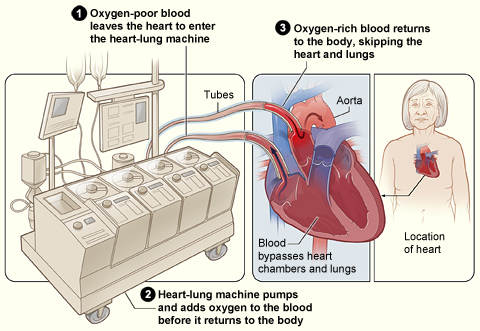What To Expect During Heart Surgery
Heart surgery is done in a hospital. A team of
experts is involved. Cardiothoracic surgeons perform the surgery with a team of
other doctors and nurses who assist.
The length of time for the surgery depends on the
type of surgery. CABG, the most common type of heart surgery, usually takes 3
to 5 hours.
Traditional Open-Heart Surgery
For this type of surgery, you're given medicine to
make you fall asleep. A doctor checks your heartbeat, blood pressure, oxygen
levels, and breathing during the surgery. A breathing tube is placed in your
lungs through your throat and connected to a ventilator (breathing
machine).
A surgeon makes a 6- to 8-inch incision (cut) down
the center of your chest wall. Your chest bone is cut and your rib cage is
opened so that the surgeon can get to your heart.
You're given medicine to thin your blood and keep it
from clotting. A heart-lung bypass machine is connected to your heart. This
machine takes over for your heart by replacing the heart's pumping action. A
specialist oversees the machine. The bypass machine allows the surgeon to
operate on a heart that isn't moving and full of blood.
Heart-Lung Bypass Machine

The illustration shows a heart-lung
bypass machine attached to a heart during surgery.
You're given medicines to stop your heartbeat once
you're connected to the heart-lung bypass machine. A pipe is placed in your
heart to drain blood to the machine. The machine removes carbon dioxide (a
waste product) from your blood, adds oxygen, and then pumps the blood back into
your body. Tubes are inserted into your chest to drain fluid.
Once the bypass machine begins to work, the surgeon
performs the surgery to repair your heart problem.
At the end of the surgery, your heart is restarted
using mild electric shocks. The pipes and tubes are removed from your heart,
and the heart-lung bypass machine is stopped. You're given medicine to allow
your blood to clot again.
Your chest bone is closed with wires. Stitches or
staples are used to close the incision. The breathing tube is removed.
An advantage of traditional open-heart surgery is
that it's easier for the surgeon to operate. This is very important for long
and complex surgeries.
Off-Pump Heart Surgery
This type of surgery is the same as traditional
open-heart surgery, except you aren't connected to a heart-lung bypass machine.
Instead, your heart is steadied with a mechanical device while the surgeon
works on it. Your heart continues to pump blood to your body.
The advantages of off-pump heart surgery are:
- No complications related to using a heart-lung
bypass machine
- Faster recovery from the surgery
Minimally Invasive Heart Surgery
For this type of heart surgery, the surgeon makes
small incisions in the side of your chest between the ribs. These incisions can
be as small as 2 to 3 inches. Then the surgeon inserts surgical tools through
these small incisions. A tool with a small video camera at the tip also is
inserted through an incision. This allows the surgeon to see inside the body.
Some types of minimally invasive heart surgery use a
heart-lung bypass machine; other types don't.
The advantages of minimally invasive heart surgery
are:
- Less bleeding during surgery and a lower chance
of needing a
blood
transfusion
- Lower risk of infection
- Less pain
- Smaller incisions and scars
- A shorter hospital stay and faster recovery
Patients who don't need the heart-lung bypass
machine aren't at risk for the complications that the machine may cause.
|

